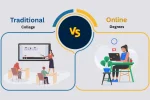How U.S. Schools Are Addressing the Youth Mental Health Crisis: The mental health of American youth is facing a historic crisis. Rising rates of anxiety, depression, self-harm, and suicidal thoughts have become deeply concerning trends among children and teens. Factors like social media, academic pressure, family instability, and the aftermath of the pandemic have all intensified the issue. Today, more than ever, schools are on the front lines, not just for education—but for mental wellness too.
This article explores how U.S. schools are addressing the youth mental health crisis through innovative programs, supportive legislation, and community-focused strategies. From classroom practices to statewide reforms, the education system is adapting to meet students’ emotional needs in meaningful and lasting ways.
How U.S. Schools Are Addressing the Youth Mental Health Crisis
Schools have become critical spaces for tackling the youth mental health crisis. Educators, counselors, and administrators are implementing both preventative and responsive strategies, recognizing that students cannot thrive academically if they are struggling emotionally. With the help of federal investments, mental health legislation, school-based services, and trauma-informed training, schools are beginning to embed wellness into their core missions. Programs like peer-led support groups, mindfulness exercises, and early screenings are helping to create safer, more supportive learning environments. These efforts, while not perfect, show promising signs that schools are committed to turning the tide on this mental health emergency.
Overview Table
| Initiative | Description |
| Mental Health Curriculum | States mandating mental health education in K-12 |
| School-Based Health Centers | On-site clinics offering mental and physical care |
| Peer-to-Peer Programs | Students trained to support classmates and reduce stigma |
| MTSS (Multitiered System of Supports) | Tiered support for emotional and behavioral needs |
| Federal and State Funding | Billions allocated to expand school mental health services |
| Trauma-Informed Teaching | Educator training to recognize and respond to emotional stress |
| Governor-Led Policy Initiatives | State-level collaboration on youth mental wellness |
The Scope of the Crisis
Today’s youth face overwhelming mental health challenges. One in six students experiences a diagnosable mental health condition each year, but only about half receive treatment. High schoolers, in particular, report increasing rates of anxiety and depression. In some districts, nearly one in five students has considered suicide.
The causes are multifaceted—ranging from cyberbullying and academic competition to pandemic trauma and social isolation. As these trends worsen, schools are being called to respond not just as educators, but as wellness hubs that offer safe, structured mental health interventions.
Federal and State Policy Boosts
To respond to the growing crisis, lawmakers are enacting new policies and expanding funding. Several states have mandated mental health education across grade levels. These curriculums aim to teach students about emotional regulation, coping skills, and how to seek help.
States like California are leading the charge—investing over $4.7 billion into school-based mental health systems. Meanwhile, the National Governors Association (NGA) launched a policy academy where states like Kentucky and Virginia collaborate across education and health departments to improve access and outcomes.
These top-down changes are empowering schools to act with more resources and clearer direction.
School-Based Mental Health Programs
One of the most effective tools schools use is the School-Based Health Center (SBHC). These in-school clinics offer integrated services like therapy, wellness checks, and crisis intervention. Because they’re located on campus, they reduce logistical barriers that keep students from getting help.
Additionally, Peer-to-Peer programs like Hope Squad are gaining traction. These student-led groups help identify classmates in distress and connect them to trusted adults. By fostering a culture of openness and empathy, they reduce stigma and increase help-seeking behavior among teens.
Evidence-Based Approaches
The Centers for Disease Control and Prevention (CDC) outlines proven mental health strategies in its Mental Health Action Guide. The most effective include:
- Multitiered Systems of Support (MTSS): A layered approach that provides universal support to all students, targeted interventions for those at risk, and intensive care for those in crisis.
- Early screening: Identifying warning signs before problems escalate.
- Referral networks: Connecting students to school psychologists, community clinics, or telehealth professionals quickly and efficiently.
These approaches emphasize both prevention and timely response, improving outcomes across diverse school environments.
Success Stories & Impact
When implemented correctly, school-based mental health initiatives deliver results. In districts that added clinical therapists and mindfulness practices, schools saw up to a 59% reduction in serious behavioral incidents.
In Georgia, daily mindfulness sessions helped reduce anxiety and improve focus. Students reported feeling more in control of their emotions, while teachers saw improvements in classroom behavior.
These stories show that even small, consistent practices—like morning breathing exercises or weekly check-ins—can make a major difference.
Current Hurdles
Despite the progress, significant barriers remain:
- Funding Gaps: In some rural areas, recent cuts to federal grants have halted mental health services altogether.
- Uneven Access: Some states fully embrace mental health reforms, while others lag behind.
- 988 Hotline Underuse: The nationwide mental health crisis line, while promising, has seen uneven adoption due to lack of awareness or state infrastructure.
Additionally, there’s a shortage of trained counselors. Many schools have just one psychologist per 1,000 students—far above the recommended ratio of 1:250.
What Schools Are Doing Differently
To meet these challenges, schools are taking innovative steps:
- Cross-sector collaboration: Schools now partner with health departments, justice systems, and community organizations to support students more holistically.
- Embedded wellness in routines: Morning check-ins, quiet zones, and scheduled mental health breaks are becoming part of daily school life.
- Professional development: Teachers receive trauma-informed training, helping them better support students and manage classrooms with empathy.
The goal is not to replace therapists with teachers, but to ensure every adult in the school understands their role in supporting student well-being.
FAQs
1. Why are schools central to youth mental health?
Because students spend most of their time in school, it becomes the ideal setting for early detection, support, and consistent care.
2. What is MTSS and why does it matter?
MTSS is a three-tiered support framework that ensures every student gets the level of help they need—from general wellness education to one-on-one counseling.
3. How do peer programs like Hope Squad help?
They empower students to recognize signs of distress among peers and connect them with trusted adults, creating a safer and more inclusive school culture.
4. Are school-based health centers effective?
Yes. SBHCs reduce absenteeism, improve academic outcomes, and provide mental health care in a setting students trust.
5. What states are leading in youth mental health policy?
California, New Jersey, Virginia, and Kentucky are among those investing heavily in mental health services, education, and cross-agency collaboration.
Final Thoughts
The youth mental health crisis won’t be solved overnight—but U.S. schools are stepping up in powerful ways. Through new legislation, school-based services, trauma-informed practices, and innovative peer programs, they’re creating safer, more nurturing environments. These efforts won’t replace the need for systemic change, but they offer a strong start.
Whether you’re a parent, educator, or student—get involved. Advocate for stronger programs, attend school board meetings, or simply ask how your local school supports student wellness. The future of our youth depends on all of us.















